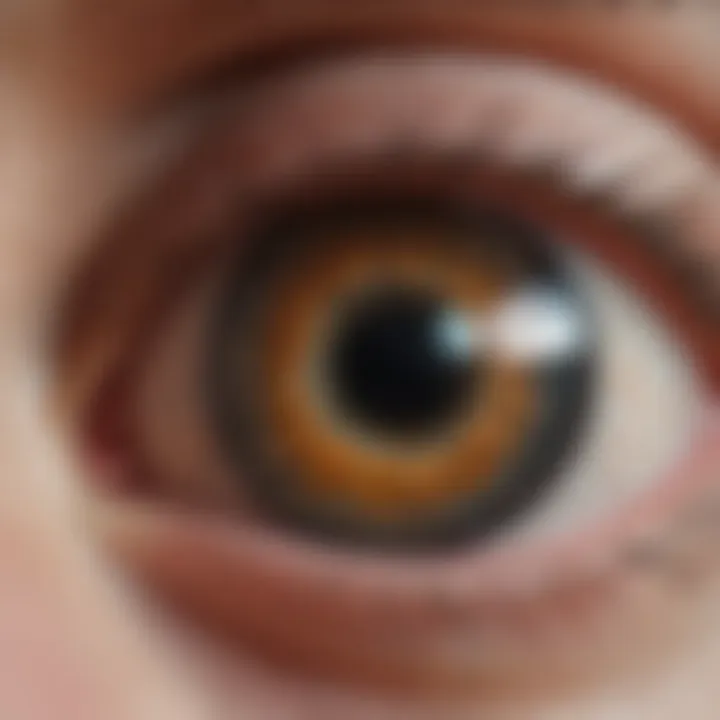IOL Cataract: Intraocular Lenses in Surgery


Intro
Cataracts affect a significant portion of the global population. As the eye's lens becomes cloudy, vision deteriorates. This medical condition often necessitates surgical intervention. Intraocular lenses, or IOLs, play a crucial role in restoring vision post-cataract surgery. They replace the natural lens, ensuring light can properly focus on the retina. Understanding IOLs requires a look at their types, benefits, and challenges. This section will set the stage for a discussion on how these lenses work, what innovations are shaping their use, and the implications for patient care.
Research Overview
Cataract surgery and the use of IOLs have been subjects of extensive research. Understanding recent findings can provide insights into effective surgical techniques and patient outcomes.
Methodological Approaches
Studies typically involve a mix of clinical trials, observational studies, and technology assessments. These evaluations often compare different IOL types in various patient demographics.
- Clinical trials: Systematic investigations to assess safety and effectiveness.
- Observational studies: Long-term follow-ups on patient experiences post-surgery.
- Technology assessments: Reviews of new developments in IOL design and materials.
Significance and Implications
The findings from recent studies are significant. They contribute to better surgical practices, leading to enhanced patient satisfaction. As the population ages, the demand for effective cataract treatments will likely rise. Understanding these trends is essential for healthcare professionals.
"The evolution of IOL technology is reshaping patient outcomes in cataract surgery."
Current Trends in Science
Recent advancements in IOL technology reflect ongoing changes in ophthalmic surgery.
Innovative Techniques and Tools
Surgeons today benefit from tools that enhance precision. Techniques like femtosecond laser-assisted cataract surgery offer new possibilities. These innovations have positively impacted how IOLs are placed. Key trends include:
- Customized IOLs: Tailored to individual patient needs, improving outcomes.
- Extended depth of focus IOLs: Providing a range of vision, reducing dependence on glasses.
Interdisciplinary Connections
The integration of various disciplines is noteworthy. Collaboration among ophthalmologists, optometrists, and researchers leads to shared knowledge. This connection enhances the development of new IOLs and techniques. The exchange of information promotes better surgical protocols that prioritize patient care.
This foundational overview sets the stage for a deeper understanding of IOLs and their role in managing cataracts. By elaborating on these points, we pave the way to exploring specific types of IOLs, their benefits, and patient outcomes in the following sections.
Preamble to Cataracts
Cataracts represent a significant health issue worldwide, fundamentally affecting the normal functioning of the eye. Understanding this condition is crucial for grasping the essential role of intraocular lenses (IOLs) in the surgical management of cataracts. This section examines the foundational elements of cataracts, their definitions, and their impacts on individuals' health and vision.
Definition of Cataracts
Cataracts refer to the clouding of the eye's natural lens, which leads to a decrease in vision quality. This condition can develop in one or both eyes and generally progresses gradually. The lens, which is located behind the iris and pupil, is primarily composed of water and proteins. With age, the proteins can clump together, forming cloudy areas and resulting in impaired light passage through the lens. Specific risk factors that contribute to cataract development include age, diabetes, exposure to ultraviolet light, smoking, and certain medications. In essence, cataracts are a normal part of the aging process for many, but they can significantly affect one’s visual capabilities.
Prevalence and Impact
The prevalence of cataracts is staggering; they are one of the leading causes of visual impairment globally. According to the World Health Organization, by 2050, the predicted number of people suffering from cataracts may exceed 150 million. This figure highlights a pressing public health issue. Cataracts not only impact the individual's quality of life but also present broader socio-economic challenges. People with cataracts may experience difficulties in daily tasks, reduced productivity at work, and increased dependence on caregivers. The emotional toll cannot be overlooked either, as individuals may feel frustrated or helpless with their declining vision.
"Cataracts are the most common cause of blindness around the world, and awareness is key to early diagnosis and treatment."
As the global population ages, it becomes increasingly important to understand cataracts and their implications deeply. Early intervention and the advent of advanced surgical techniques have transformed cataract surgery into one of the safest and most effective procedures performed today. The following sections will delve further into the eye’s anatomy, surgical options, and the intricate technologies that support improved vision post-surgery.
Anatomy of the Eye
Understanding the anatomy of the eye is crucial for grasping the role and functioning of intraocular lenses. Each component of the eye plays a specific part in vision. The health and clarity of these components can significantly impact visual outcomes, especially after cataract surgery. The anatomy details how light enters the eye, is focused, and ultimately received by the retina, creating the images we see. It is important to focus on each component, as they interrelate and affect each other's performance.
Components of the Eye
Cornea
The cornea is the clear, outermost layer of the eye. It serves as a barrier against dirt, germs, and other particles that could harm the inner components. This clarity and protective role are essential for clear vision, as it refracts light that enters the eye. A key characteristic of the cornea is its curvature, which helps focus light effectively. The cornea is an advantageous element in the eye because it does not have blood vessels, allowing for increased transparency.
However, its susceptibility to injury and disease needs consideration. For patients undergoing cataract surgery, a healthy cornea is critical since any issues may compromise visual outcomes with new intraocular lenses.
Iris
The iris is the colored part of the eye and plays a significant role in controlling the size of the pupil. This regulation under different lighting conditions is essential for optimal vision. A key characteristic of the iris is its ability to adjust quickly, adapting to various levels of brightness. This adaptability contributes to visual comfort and overall eye health.
For this article, understanding the iris is beneficial as it contextualizes how cataracts can alter its function, impacting the management in cataract surgeries. One can mention that certain iris-related issues may complicate the surgical process, so careful observation is necessary.
Lens
The lens is another fundamental component of the eye. It sits behind the iris and further refines the focus of the light onto the retina. A unique feature of the lens is its ability to change shape, allowing for focusing on objects at different distances. This property is crucial for a clear vision.
In the context of IOLs, a healthy lens is vital before cataract surgery. The loss of lens clarity due to cataracts directly motivates the need for intraocular lenses. Hence, appreciating the lens's role enhances the understanding of how IOLs compensate for its loss.
Retina
The retina is at the back of the eye and is responsible for converting light signals into neural signals sent to the brain. A key characteristic of the retina is its ability to process a wide array of light wavelengths, facilitating color perception and detail recognition. This makes the retina indispensable for visual clarity.
For those looking into cataract surgery, recognizing the retina's functionality is critical. If the retina is damaged or degenerative, even optimal IOL placement may not restore vision fully.


Role of the Lens
The lens in the eye plays an indispensable role by providing focus, clarity, and precision in vision. It delivers images in a manner that the brain can interpret correctly, working with the cornea for optimal light refraction. A healthy lens maintains the eye’s accommodation ability, allowing seamless transition between near and far vision. Degradation of the lens due to cataracts highlights the essential nature of IOLs, which serve to replace its function after surgical removal.
Intraocular Lenses (IOLs) Explained
Intraocular lenses (IOLs) play a pivotal role in modern cataract surgery. Their introduction revolutionized how practitioners approach the treatment of cataracts. The lens replacement can restore vision effectively, addressing both the symptoms of cataracts and the underlying vision impairments.
IOLs are specifically designed optical devices implanted in the eye during cataract surgery to replace the eye's natural lens that has become cloudy due to cataracts. Their primary purpose is to refract light to produce clear images on the retina, thereby improving vision. IOLs come in various types, each tailored to meet specific vision needs of patients. This adaptability is one of the core advantages of IOLs, making them suitable for a diverse range of individuals based on their visual requirements.
Benefits of IOLs:
- Enhanced visual acuity compared to uncorrected vision.
- Options for patients with different vision needs, such as distance or near vision.
- Reduced reliance on corrective eyewear in many cases.
However, selecting the appropriate IOL involves careful consideration of the patient's lifestyle and vision goals, as each type presents unique features and potential outcomes.
What are IOLs?
Intraocular lenses (IOLs) are artificial lenses implanted into the eye during cataract surgery. They serve as the replacement for the natural lens that is removed due to cataract formation. Typically made from flexible plastic or silicone, IOLs are designed to be biocompatible, allowing them to integrate seamlessly within the eye. The procedure to insert an IOL is performed using minimally invasive techniques, often resulting in quicker recovery times.
Patients often have choices concerning the type of IOL they receive. These choices are determined by their visual requirements and the extent of their cataracts. The most common types include monofocal, multifocal, toric, and accommodative lenses. Each type provides distinct advantages depending on individual needs and preferences.
History and Development of IOLs
The history of intraocular lenses began in the mid-20th century. Dr. Harold Ridley is credited with the first successful implantation of an IOL in 1949. Initially, IOLs faced challenges regarding acceptance and effectiveness, as early models often resulted in postoperative complications.
Over the decades, significant advancements in design and materials led to improved patient outcomes. Today, IOLs are manufactured using advanced polymers and are shaped to optimize light refraction. The designs cater to various vision needs, allowing customization based on patient profiles.
"The evolution of IOL technology illustrates tremendous advancements in surgical outcomes and patient satisfaction."
As technology progressed, there was an increase in options available for the patients. This includes lenses that correct astigmatism and others that allow for near, intermediate, and distance vision. These tailored solutions contribute to the effectiveness and versatility of cataract surgery in improving overall quality of life for patients.
Types of Intraocular Lenses
Understanding the types of intraocular lenses (IOLs) is vital in the context of cataract surgery. Each type has unique attributes that cater to different vision needs. Choosing the right lens can significantly affect the outcome of the surgery and the quality of life for the patient post-operation.
The main categories of IOLs include monofocal, multifocal, toric, and accommodative lenses. Each offers various benefits and has specific considerations.
Monofocal Lenses
Monofocal lenses are designed to provide clear vision at one distance. They are the most commonly used IOLs in cataract surgeries. Patients usually select whether they want to see clearly up close, far away, or at a moderate distance. After implantation, many find they require glasses for tasks beyond the selected focal point.
Benefits of monofocal lenses include:
- Simplicity: They have a straightforward design and predictable results.
- Cost-effective: Usually, they are less expensive compared to other types of IOLs.
- Widely available: Available in various materials, such as acrylic and silicone, accommodating many patients.
However, patients should be aware that relying on monofocal lenses might still lead to a dependency on glasses for certain activities.
Multifocal Lenses
Multifocal IOLs provide multiple focal points. This means that patients can see at various distances without requiring glasses for most activities. They incorporate different lens zones to allow clear vision for near, intermediate, and distance tasks. This can enhance freedom from glasses after surgery.
Key points about multifocal lenses:
- Versatility: They allow for a broader range of vision.
- Reduced need for corrective lenses: Many patients report less dependency on glasses post-surgery.
On the downside, some patients may experience visual disturbances, such as glare or halos around lights, especially at night.
Toric Lenses
Toric IOLs are specialized lenses designed to correct astigmatism in addition to addressing cataracts. Astigmatism is caused by an irregular shape of the cornea, which results in blurred vision. Toric lenses have different powers in different meridians of the lens, correcting the uneven curvature.
Advantages of toric lenses include:
- Astigmatism correction: They can significantly improve overall visual quality for those with pre-existing astigmatism.
- Customized options: Available in various degrees of astigmatism correction, catering to individual patient needs.
However, proper alignment during surgery is crucial for optimal results.
Accommodative Lenses
Accommodative lenses are designed to move within the eye. They mimic the natural lens's ability to change shape to focus on objects at varying distances. By shifting position, these lenses allow for improved vision across a range of distances.
Benefits of accommodative lenses:
- Natural feel: They offer a more natural vision experience similar to that of a youthful lens.
- Reduced reliance on glasses: Many find they need glasses less frequently for various tasks.
Despite these advantages, outcomes may vary. Some users might still find they require glasses, especially for specific tasks or lighting conditions.
The choice of IOL can significantly impact post-surgery satisfaction. Discussing options thoroughly with an eye care professional is essential for determining the most suitable lens type.
Indications for Using IOLs


Intraocular lenses (IOLs) play a significant role in the management of cataracts and vision correction. Understanding the indications for using IOLs is crucial for both patients and healthcare providers. The two primary areas where IOLs are indicated are cataract surgery and vision correction. Each of these areas has distinct considerations and benefits.
Cataract Surgery
Cataract surgery is the most prevalent surgical procedure performed globally. It involves the removal of the clouded natural lens of the eye and the insertion of an intraocular lens. The main indication for this surgical intervention is when cataracts cause significant visual impairment that affects daily activities. The presence of cataracts can lead to blurred vision, difficulty in seeing at night, and faded colors, among other issues.
Prior to surgery, a comprehensive evaluation is conducted. Eye specialists use various diagnostic methods, like optical coherence tomography and ultrasound biometry, to assess the extent of the cataract and determine the appropriate type of IOL to use. It’s essential to select the correct IOL as it can directly impact the visual recovery and quality of life after the procedure. Generally, patients who experience significant difficulties in performing daily tasks due to cataracts are the most likely candidates for IOL implantation during surgery. This surgical approach allows for improved vision and a greater overall quality of life.
Vision Correction
In addition to cataract treatment, IOLs are also indicated for vision correction beyond the removal of cataracts. Some patients may opt for IOLs to address refractive errors such as myopia, hyperopia, or astigmatism. Depending on the lens type selected, patients can achieve clearer vision without the reliance on glasses or contact lenses.
Benefits include:
- Improved visual clarity for near and distance tasks.
- Reduced dependency on visual aids.
- Potentially enhanced quality of life.
- Flexibility to choose various types of lenses designed for multifocal or toric corrections.
Choosing to use IOLs for vision correction requires careful discussion between the patient and the eye care professional, weighing the risks versus the anticipated benefits. Patients should be aware of the possibilities and limitations associated with different types of lenses.
In summary, the indications for using IOLs are critically linked to both cataract surgery and broader vision correction needs. Surgical candidates dealing with cataracts are primarily chosen based on the impact of their condition on daily functionalities. Simultaneously, newer advancements in IOL technology offer solutions for patients looking to improve their vision and reduce dependence on corrective eyewear.
"The choice of an IOL must be individualized based on patient needs and pre-existing eye conditions."
Understanding these indications can aid in making informed decisions about surgical options and expectations following cataract surgery or vision correction procedures.
The Cataract Surgery Process
The process of cataract surgery is a pivotal aspect in the treatment of cataracts. It involves several important stages that ensure the safe and effective removal of cloudy lenses and the subsequent implementation of intraocular lenses (IOLs). Understanding this process helps demystify what patients can expect, alleviating anxiety and improving overall outcomes. The surgery not only aims to restore vision but also considers factors like patient health, the type of cataract, and the specific IOL chosen.
Pre-operative Assessments
Before surgery, thorough pre-operative assessments are crucial. These assessments typically include a comprehensive eye exam, reviewing medical history, and various tests to measure the eye's refractive power.
Patients might undergo optical coherence tomography (OCT) to analyze the retina, and keratometry to evaluate the curvature of the cornea. These evaluations are important to help the surgeon determine the best IOL and the correct power needed. The results of these tests assist in minimizing postoperative complications and tailoring the surgery to individual needs.
In addition, discussing medications is critical. Patients may need to adjust or stop taking certain drugs prior to surgery. These assessments help set a baseline for patient health and readiness, ensuring effective communication throughout the surgical journey.
Surgical Techniques
Cataract surgery generally employs two main techniques: phacoemulsification and extracapsular surgery. Each of these techniques offers distinct approaches to lens removal, and understanding them aids in grasping the overall surgical process.
Phacoemulsification
Phacoemulsification is widely used and regarded as a standard procedure for cataract removal today.
This technique involves the use of ultrasound waves to break the cloudy lens into small pieces, which can then be suctioned out.
A key characteristic of phacoemulsification is its minimally invasive nature, resulting in smaller incisions compared to traditional surgery. This aspect contributes to reduced recovery times and can lead to lower post-operative complications.
One unique feature of phacoemulsification is the use of viscoelastic substances during the procedure. These substances help maintain the shape of the anterior chamber and protect the corneal endothelium during lens removal.
The advantages of phacoemulsification include less trauma to the eye and quicker visual recovery, making it a beneficial choice for many patients. However, there are potential disadvantages, such as the need for significant surgical skill and advanced equipment, which may not be available in all settings.
Extracapsular Surgery
Extracapsular surgery is another approach utilized in cataract removal, though less common today. It involves removing the lens in one piece, leaving the back of the lens capsule intact.
This technique is highlighted by its relative simplicity, making it a viable option in certain cases, particularly in patients with advanced cataracts or other complicating factors.
The unique feature of extracapsular surgery is its capacity to deliver a consistent outcome in eye surgeries with less dependence on high-tech equipment.
The advantages of this approach include a potentially lower risk of complications during surgery; however, drawbacks may include longer recovery times and a greater likelihood of more extensive postoperative medications.
Ultimately, the choice of surgical technique depends on various factors, including the surgeon's expertise and the specific needs of the patient.
Understanding the intricacies involved in these techniques enhances the overall awareness of patients entering into cataract surgery.
Benefits of IOLs
Intraocular lenses (IOLs) represent a significant advancement in the management of cataracts. They not only replace the clouded lens but also provide various benefits that can enhance a patient’s quality of life post-surgery. Understanding the benefits of IOLs is essential for patients considering cataract surgery. This section delves into the two primary advantages: improved vision and reduced dependency on glasses.
Improved Vision
The primary reason patients undergo cataract surgery is to restore vision. IOLs are designed to mimic the natural lens of the eye, allowing for clearer and sharper visual acuity. Unlike glasses, which can fog up or slip down the nose, IOLs are permanently placed inside the eye.
Patients typically report significant improvements in their ability to perform daily activities like reading, driving, or engaging in hobbies.
- High Visual Acuity: Studies show that many patients gain 20/25 vision or better after surgery with IOLs.
- Better Contrast Sensitivity: IOLs can enhance the contrast sensitivity, which is crucial for tasks like night driving.
"Many patients express a sense of relief and happiness after surgery due to the remarkable shift from blurred to clear vision."
This restoration of vision plays a vital role in the overall satisfaction of patients. Particularly for those who had been reliant on thick glasses, the transition can be profound.
Reduced Dependency on Glasses
Another significant benefit of IOLs is the potential decrease in reliance on corrective eyewear. Prior to surgery, many patients may have worn glasses full-time to compensate for their impaired vision caused by cataracts. With the right type of IOL, such as multifocal or accommodating lenses, patients can often see clearly at various distances without glasses.
- Enhanced Daily Life: Less dependence on glasses can simplify routine tasks and activities, from reading a menu to watching television.
- Freedom of Movement: Patients often feel freer to engage in physical activities without the worry of glasses.
The choice of IOL can influence this outcome. Multifocal lenses allow for vision correction at multiple distances, while accommodating lenses mimic the eye’s natural ability to focus. This results in a more natural visual experience post-surgery.
Potential Risks and Complications
Understanding the potential risks and complications related to intraocular lenses (IOLs) is crucial for patients undergoing cataract surgery. While IOLs have significantly improved vision outcomes for many, they are not without drawbacks. Recognizing these aspects is vital in making informed decisions regarding surgery and lens selection.
Post-operative follow-up is important, as patients may face some challenges that could interfere with their recovery or satisfaction. Likewise, long-term risks need consideration, as they can affect an individual's quality of life years after the procedure.


Post-operative Challenges
After cataract surgery, patients may encounter several challenges as they adjust to their new IOLs. Common post-operative issues include:
- Visual Disturbances: Some patients report sensations of glare, halos around lights, or fluctuating vision during the initial recovery phase. These disturbances can be particularly noticeable during nighttime or low-light conditions.
- Dry Eyes: Post-surgery, many experience dryness in their eyes. This symptom can lead to discomfort and may require ongoing artificial tear solutions to manage effectively.
- Infection Risk: Though rare, post-operative infections can occur. The risk is higher if patients do not follow post-operative care instructions, such as using prescribed eye drops.
- Inflammation: Inflammatory reactions may develop, potentially impacting visual clarity and comfort.
Effective communication with healthcare providers about these challenges is essential. Regular follow-up appointments help address concerns and enable prompt treatment if complications arise.
Long-term Risks
Evaluating long-term risks associated with IOLs is equally as important. Patients should be aware of the following potential complications that may manifest months or years post-surgery:
- IOL Displacement: An IOL may shift from its original position, leading to blurred vision or other visual disturbances. In some cases, repositioning the lens may be necessary.
- Posterior Capsule Opacification (PCO): This condition, often referred to as a secondary cataract, occurs when the membrane behind the lens becomes cloudy. It generally can be treated effectively with a simple outpatient procedure called YAG laser capsulotomy.
- Glaucoma Risk: Some types of IOLs can potentially increase intraocular pressure, raising the risk of glaucoma, particularly in susceptible individuals. Regular monitoring is necessary to detect changes early.
- Complications from Additional Procedures: Future ocular procedures may become more complex due to the presence of IOLs. This factor should be discussed with eye care professionals well in advance.
Being proactive about understanding and managing these risks can enhance patient outcomes and satisfaction. Eye care professionals can provide detailed information tailored to individual needs, ensuring a balanced view of both the benefits and challenges associated with IOLs.
Informed patients who understand both benefits and risks tend to have the most successful outcomes in cataract surgery.
Through comprehensive education, patients become empowered to make choices that align with their personal vision goals.
Evaluating IOL Performance
Evaluating the performance of intraocular lenses (IOLs) is crucial in understanding their effectiveness and impact on patient outcomes in cataract surgery. The success of IOLs is measured through various parameters, including visual acuity and patient satisfaction. Both aspects contribute significantly to the overall assessment of how well a specific lens performs in real-world scenarios.
Visual Acuity Outcomes
Visual acuity is often regarded as the primary measure of a successful cataract surgery. This metric assesses the clarity and sharpness of vision achieved after the implantation of an IOL. High visual acuity outcomes indicate that the lens effectively replaces the natural lens, significantly improving patients’ quality of life.
Studies have shown that the choice of IOL type can affect visual acuity outcomes. Factors such as lens design, optical quality, and the individual’s pre-existing vision problems all play a role in determining these results. For instance, monofocal lenses typically provide excellent distance vision but may necessitate glasses for near tasks.
In contrast, multifocal and accommodating lenses aim to offer good vision at multiple distances. Such options can improve overall satisfaction by reducing the dependency on corrective eyewear. However, these lenses may also result in compromises, such as decreased contrast sensitivity. A clear understanding of these outcomes is essential for both patients and surgeons when making decisions about IOL selection.
Patient Satisfaction Studies
Patient satisfaction serves as an equally important metric in evaluating IOL performance. It encompasses not only the visual outcomes but also the overall experience patients have before, during, and after the surgery. Satisfaction studies often utilize surveys that assess patients' perceptions of their vision, functional abilities, and everyday life after cataract surgery.
Research has indicated that satisfied patients report better quality of life and enhanced functionalities in daily activities. These studies frequently highlight the influence of factors such as vision clarity, freedom from glasses, and recovery experience. Complications and side effects can detract from satisfaction levels, which underlines the importance of thorough preoperative counseling and postoperative follow-up.
Gathering data from patient satisfaction studies enables healthcare professionals to identify areas needing improvement in the overall surgical process. This feedback loop is vital because it informs future practices and helps in the selection of IOLs that align with patient expectations and needs.
"The true measure of IOL performance can only be fully realized through the combined analysis of objective visual outcomes and subjective patient satisfaction."
Future Trends in IOL Technology
Intraocular lenses (IOLs) play a critical role in cataract surgery. As the need for effective solutions to vision problems increases, it is essential to explore future trends in IOL technology. This section addresses innovations and advancements that shap future developments in this area. Understanding these trends is crucial both for patients considering surgery and for professionals in the field, as it aids in making informed decisions regarding treatment options and improving patient outcomes.
Innovations in IOL Design
Recent technological advancements have positioned IOLs to evolve significantly. New materials and design strategies are being implemented to enhance the performance of these lenses. One of the notable trends is the development of biocompatible materials. These materials can better integrate with the eye’s natural tissues, which minimizes complications and improves healing.
Another significant innovation is the use of wavefront technology which assists in creating IOLs tailored to each patient's unique visual requirements. This customization addresses common issues like astigmatism and presbyopia, potentially leading to superior visual outcomes post-surgery.
Moreover, the shift towards smart IOLs is creating excitement. These lenses are designed to adjust focus in response to changing light conditions, mimicking natural eye functionality more closely. This innovation promises to reduce the dependence on glasses after surgery, catering to patient preferences for clearer, more versatile vision.
"The future of IOL design is not just about correcting vision but enhancing the overall quality of life for patients."
Advancements in Surgical Techniques
As IOL designs improve, surgical techniques are also evolving to accommodate these changes. The move towards minimally invasive methods is a prominent trend. More surgeons are adopting techniques that require smaller incisions and cause less trauma to the eye. This approach leads to quicker recovery times and less post-operative discomfort.
Femtosecond laser-assisted cataract surgery marks a significant development. This technique allows for more precise cuts and fragmented lens removal, enhancing safety during the procedure. The precision of lasers contributes to improved alignment of IOLs, which is key for ultimate visual clarity.
Training and technology integration remain crucial for successful adoption of these advancements. Ongoing education ensures that surgeons are well-equipped with the knowledge necessary to utilize new tools and strategies effectively. This continuous education is vital to keep pace with rapid technological changes in the field.
The End
The conclusion of this article is vital as it synthesizes the salient points regarding intraocular lenses (IOLs) and their significance in cataract surgery. It serves as a culmination of information presented in previous sections, emphasizing the intricate relationship between cataracts, surgical techniques, and the role of IOLs in enhancing the quality of life for patients. Understanding these aspects is essential for various stakeholders, from patients to healthcare providers.
This article affords a comprehensive overview of the spectrum of IOL technologies available, their benefits, and considerations for their use. Key takeaways include the diverse types of IOLs—monofocal, multifocal, toric, and accommodative—each tailored to specific visual needs. The clear understanding of these options enables patients to make informed decisions regarding their vision health.
Moreover, the integration of advanced surgical techniques has transformed cataract surgery outcomes. Improved precision in procedures such as phacoemulsification not only enhances the efficacy of IOL implantation but also reduces recovery time for patients. This synergy between IOL technology and surgical advancement fosters better visual outcomes and patient satisfaction.
In essence, the goal of cataract surgery has evolved from merely removing the cataract to providing optimal visual restoration and reducing dependency on corrective lenses.
The implications of the findings discussed in this article extend to public health, especially in aging populations where cataract prevalence increases. Thus, a deeper understanding of IOLs and their relevant technologies is paramount for optimal patient care and future advancements in the field.
Summary of Key Points
The key points to take from this exploration into IOLs in cataract surgery include:
- The importance of IOLs as a critical component of cataract surgery, which improves vision following the removal of the cloudy lens.
- A detailed classification of IOL types, each offering different solutions based on patient needs.
- How surgical advancements contribute to better post-operative outcomes and reduced complications.
- The necessity of considering long-term risks and patient satisfaction in the selection of IOL technology.
Implications for Future Research
Future research in the field of intraocular lenses and cataract surgery likely focuses on several pivotal areas:
- Expansion of IOL technology: Continuous innovation in lens design will foster improved visual outcomes, particularly for patients with complex vision issues.
- Longitudinal studies: Examining the long-term success of various IOLs will provide deeper insights into their performance and patient satisfaction over time.
- Advancements in surgical techniques: Research directed at refining surgical approaches to IOL implantation can enhance safety and recovery.
- Patient education and awareness: Investigating how better patient education affects outcomes post-surgery could yield significant benefits in managing expectations and satisfaction levels.
Exploring these avenues could pave the way for new standards in cataract treatment, ultimately enhancing the quality of life for countless individuals.



